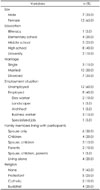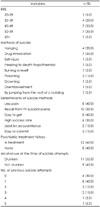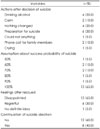Abstract
Objectives
This study was conducted to examine the factors affecting suicide decision and to understand in detail their psychological and behavioral changes with high lethality suicide attempters who were supposed to be similar to suicide completers.
Methods
Twenty patients who visited Kangwon National University Hospital or Chuncheon National Hospital participated in this study. After applying suicide lethality with Risk-Rescue Rating Scale, high lethality attempters were screened. Each subject participated in an in-depth interview with a semi-structured interview schedule.
Results
The participants had high mean Risk-Rescue Rating Score (45.0±8.7), indicating that the study was conducted with the most lethal suicide attempters. Most attempters had chosen their methods of suicide impulsively without consideration for lethality, and most attempters reported that they chose suicide methods from recall of reports by mass media ; 70% of attempters had more than one previous suicide attempt and their suicide methods have been changed to increase the suicide success rate. Most common accompanying emotions before suicide attempts were hopelessness, helplessness, worthlessness, and loneliness. Most important precipitating factors of suicide were economic difficulties.
Figures and Tables
References
1. Statistics Korea [homepage on the Internet]. Causes of death statistics in 2013. cited 2014 Dec 29. Available from: http://kostat.go.kr/portal/korea/kor_nw/2/1/index.board?bmode=download&bSeq=&aSeq=330181&ord=1.
2. Lee M, Kim S, Park J, Sim E. Factors of suicidal ideation and behavior: social relationships and family. Korea J Popul Stud. 2010; 33:61–84.
3. National assembly budget office [homepage on the Internet]. Problem of suicide prevention policy and improvements. cited 2013 Nov 28. Available from: http://www.nabo.go.kr/Sub/04Etc/popReport.jsp?funcSUB=view&bid=19&arg_id=4980#.
4. Phillips MR, Yang G, Zhang Y, Wang L, Ji H, Zhou M. Risk factors for suicide in China: a national case-control psychological autopsy study. Lancet. 2002; 360:1728–1736.

5. Cavanagh JT, Carson AJ, Sharpe M, Lawrie SM. Psychological autopsy studies of suicide: a systematic review. Psychol Med. 2003; 33:395–405.

6. Korean association for suicide prevention. A research on the construction of psychological autopsy for suicide victims and case management for suicide victims and case management for suicide attempters. Sejong: Ministry of Health & Welfare;2009.
7. Gyeonggi provincial center for suicide prevention. 2013 Gyeonggi province psychological autopsy report. Suwon: Gyeonggi Provincial Center for Suicide Prevention;2014.
8. Na KS, Paik JW, Yun MK, Kim HS. Psychological autopsy: review and considerations for future directions in Korea. J Korean Neuropsychiatr Assoc. 2015; 54:40–48.

9. Owens D, Horrocks J, House A. Fatal and non-fatal repetition of self-harm. Systematic review. Br J Psychiatry. 2002; 181:193–199.
10. Suominen K, Isometsä E, Suokas J, Haukka J, Achte K, Lönnqvist J. Completed suicide after a suicide attempt: a 37-year follow-up study. Am J Psychiatry. 2004; 161:562–563.

11. Lim M, Lee S, Park JI. Characteristics of Korean suicide attempters. J Korean Neuropsychiatr Assoc. 2015; 54:209–215.

12. Weisman AD, Worden JW. Risk-rescue rating in suicide assessment. Arch Gen Psychiatry. 1972; 26:553–560.

13. Prism.go.kr [homepage on the Internet]. Psychological autopsy studies of suicide and suicide prevention plan. Updated 2009. Available from: http://www.prism.go.kr.
14. Korean association for suicide prevention [homepage on the Internet]. Psychological and behavioral characteristics during periods of impending suicide attempt. cited 2011. Available from: http://www.suicideprevention.or.kr/.
15. Shneidman ES. The psychological pain assessment scale. Suicide Life Threat Behav. 1999; 29:287–294.
16. Rosenberg ML, Davidson LE, Smith JC, Berman AL, Buzbee H, Gantner G, et al. Operational criteria for the determination of suicide. J Forensic Sci. 1988; 33:1445–1456.

17. Jobes DA, Casey JO, Berman AL, Wright DG. Empirical criteria for the determination of suicide manner of death. J Forensic Sci. 1991; 36:244–256.

18. Potter LB, Kresnow M, Powell KE, O'Carroll PW, Lee RK, Frankowski RF, et al. Identification of nearly fatal suicide attempts: self-inflicted injury severity form. Suicide Life Threat Behav. 1998; 28:174–186.
19. Kunrath S, Baumert J, Ladwig KH. Increasing railway suicide acts after media coverage of a fatal railway accident? An ecological study of 747 suicidal acts. J Epidemiol Community Health. 2011; 65:825–828.

20. Sisask M, Värnik A. Media roles in suicide prevention: a systematic review. Int J Environ Res Public Health. 2012; 9:123–138.

21. Mann JJ, Apter A, Bertolote J, Beautrais A, Currier D, Haas A, et al. Suicide prevention strategies: a systematic review. JAMA. 2005; 294:2064–2074.
22. McGirr A, Renaud J, Bureau A, Seguin M, Lesage A, Turecki G. Impulsive-aggressive behaviours and completed suicide across the life cycle: a predisposition for younger age of suicide. Psychol Med. 2008; 38:407–417.

23. Brodsky BS, Oquendo M, Ellis SP, Haas GL, Malone KM, Mann JJ. The relationship of childhood abuse to impulsivity and suicidal behavior in adults with major depression. Am J Psychiatry. 2001; 158:1871–1877.

24. Horesh N, Rolnick T, Iancu I, Dannon P, Lepkifker E, Apter A, et al. Anger, impulsivity and suicide risk. Psychother Psychosom. 1997; 66:92–96.

25. Mccullumsmith CB, Williamson DJ, May RS, Bruer EH, Sheehan DV, Alphs LD. Simple measures of hopelessness and impulsivity are associated with acute suicidal ideation and attempts in patients in psychiatric crisis. Innov Clin Neurosci. 2014; 11:47–53.
26. Isometsä ET, Lönnqvist JK. Suicide attempts preceding completed suicide. Br J Psychiatry. 1998; 173:531–535.

27. Joiner TE. Why people die by suicide. Cambridge, MA: Harvard University Press;2005.
28. Wang LJ, Huang YC, Lee SY, Wu YW, Chen CK. Switching suicide methods as a predictor of completed suicide in individuals with repeated self-harm: a community cohort study in northern Taiwan. Aust N Z J Psychiatry. 2015; 49:65–73.

29. Huang YC, Wu YW, Chen CK, Wang LJ. Methods of suicide predict the risks and method-switching of subsequent suicide attempts: a community cohort study in Taiwan. Neuropsychiatr Dis Treat. 2014; 10:711–718.
30. Spirito A, Brown L, Overholser J, Fritz G. Attempted suicide in adolescence: a review and critique of the literature. Clin Psychol Rev. 1989; 9:335–363.

31. Beck AT, Steer RA, Kovacs M, Garrison B. Hopelessness and eventual suicide: a 10-year prospective study of patients hospitalized with suicidal ideation. Am J Psychiatry. 1985; 142:559–563.

32. Orri M, Paduanello M, Lachal J, Falissard B, Sibeoni J, Revah-Levy A. Qualitative approach to attempted suicide by adolescents and young adults: the (neglected) role of revenge. PLoS One. 2014; 9:e96716.

33. Statistics Korea [homepage on the Internet]. Social investigation report in 2014. cited 2014 Nov 27. Available from: http://kostat.go.kr/portal/korea/kor_nw/2/6/3/index.board?bmode=download&bSeq=&aSeq=332322&ord=6.




 PDF
PDF ePub
ePub Citation
Citation Print
Print






 XML Download
XML Download